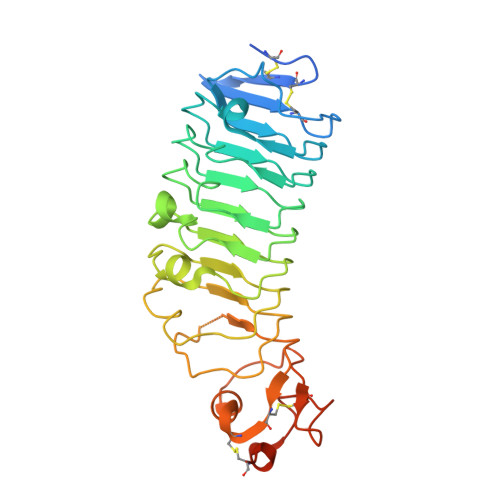Structural basis of SALM3 dimerization and synaptic adhesion complex formation with PTP sigma.
Karki, S., Shkumatov, A.V., Bae, S., Kim, H., Ko, J., Kajander, T.(2020) Sci Rep 10: 11557-11557
- PubMed: 32665594
- DOI: https://doi.org/10.1038/s41598-020-68502-4
- Primary Citation of Related Structures:
6TL8 - PubMed Abstract:
Synaptic adhesion molecules play an important role in the formation, maintenance and refinement of neuronal connectivity. Recently, several leucine rich repeat (LRR) domain containing neuronal adhesion molecules have been characterized including netrin G-ligands, SLITRKs and the synaptic adhesion-like molecules (SALMs). Dysregulation of these adhesion molecules have been genetically and functionally linked to various neurological disorders. Here we investigated the molecular structure and mechanism of ligand interactions for the postsynaptic SALM3 adhesion protein with its presynaptic ligand, receptor protein tyrosine phosphatase σ (PTPσ). We solved the crystal structure of the dimerized LRR domain of SALM3, revealing the conserved structural features and mechanism of dimerization. Furthermore, we determined the complex structure of SALM3 with PTPσ using small angle X-ray scattering, revealing a 2:2 complex similar to that observed for SALM5. Solution studies unraveled additional flexibility for the complex structure, but validated the uniform mode of action for SALM3 and SALM5 to promote synapse formation. The relevance of the key interface residues was further confirmed by mutational analysis with cellular binding assays and artificial synapse formation assays. Collectively, our results suggest that SALM3 dimerization is a pre-requisite for the SALM3-PTPσ complex to exert synaptogenic activity.
Organizational Affiliation:
Institute of Biotechnology, University of Helsinki, Viikinkaari 1, PO Box 65, 00014, Helsinki, Finland.















